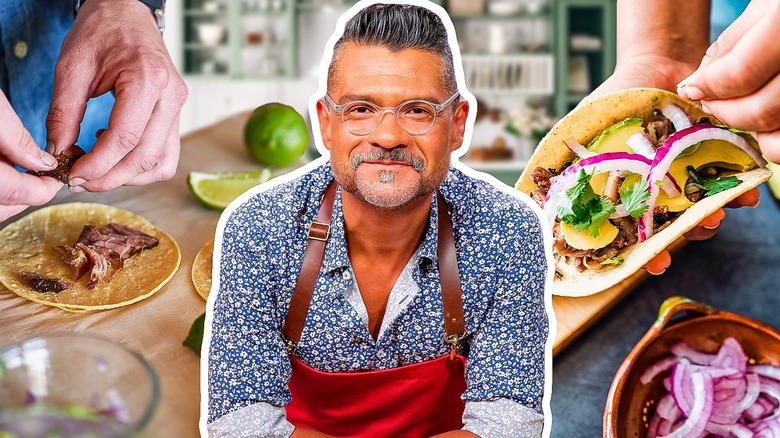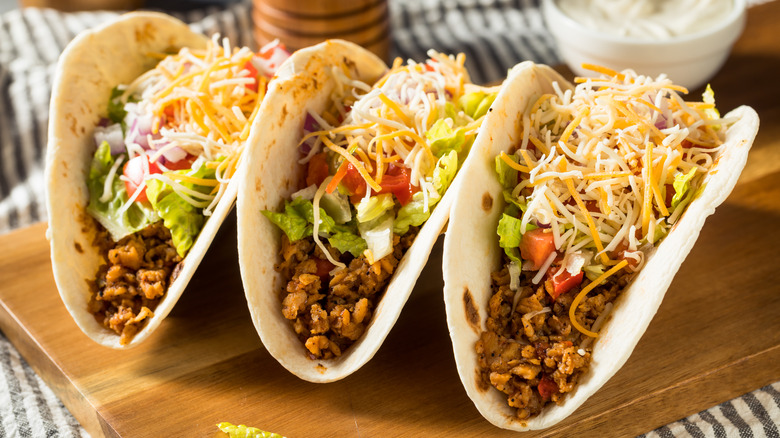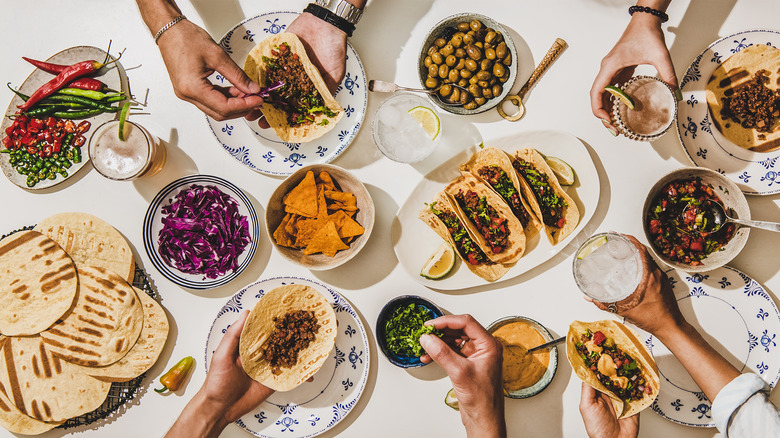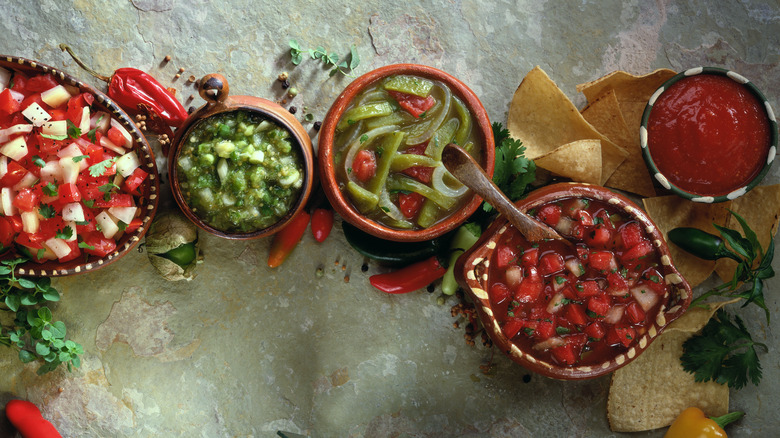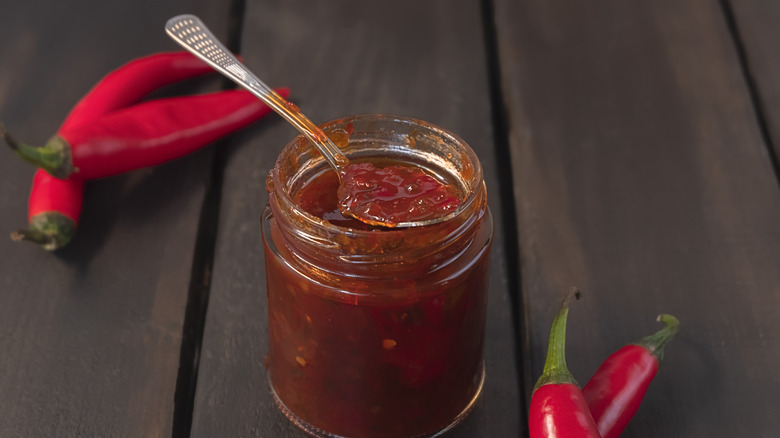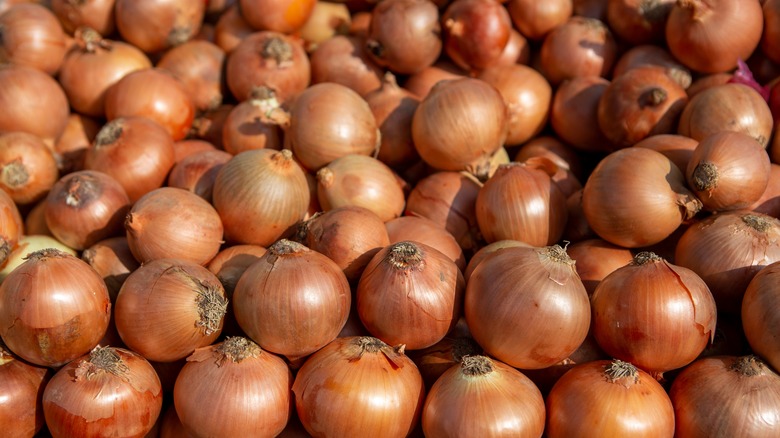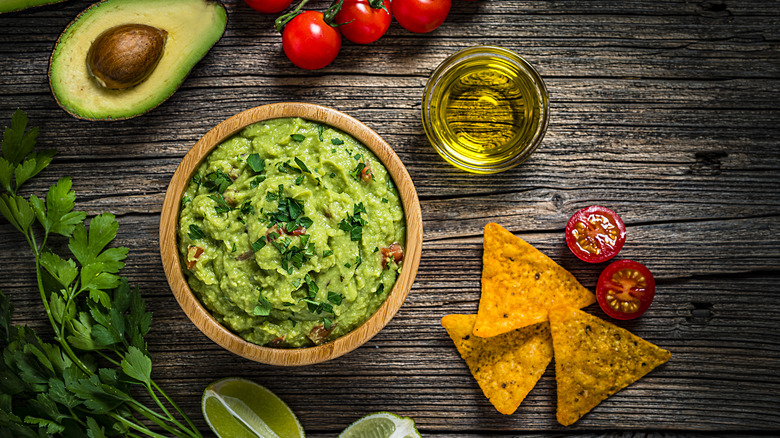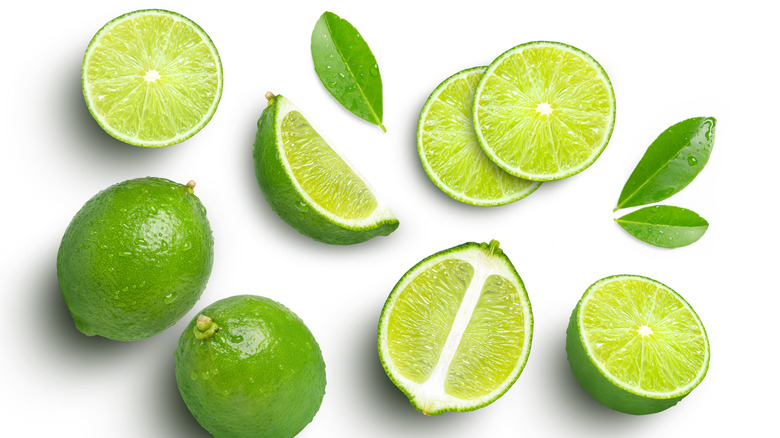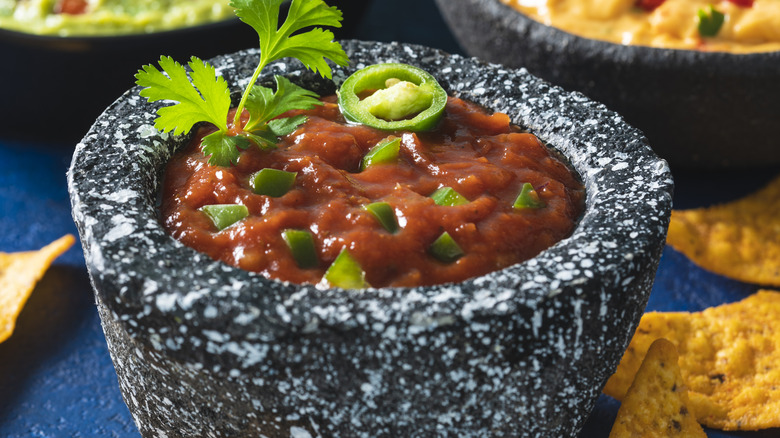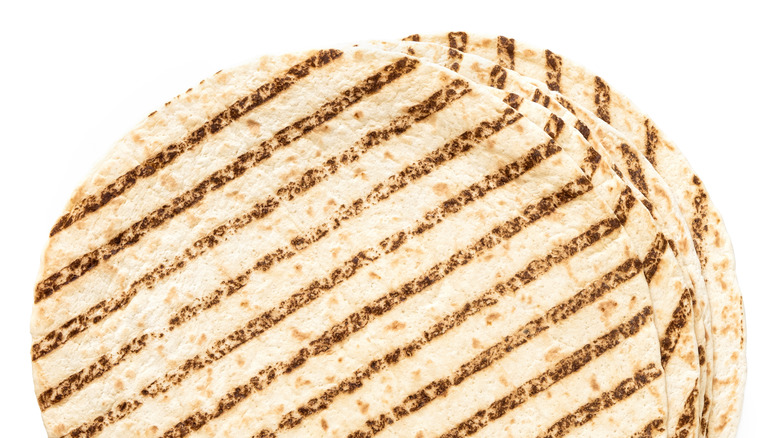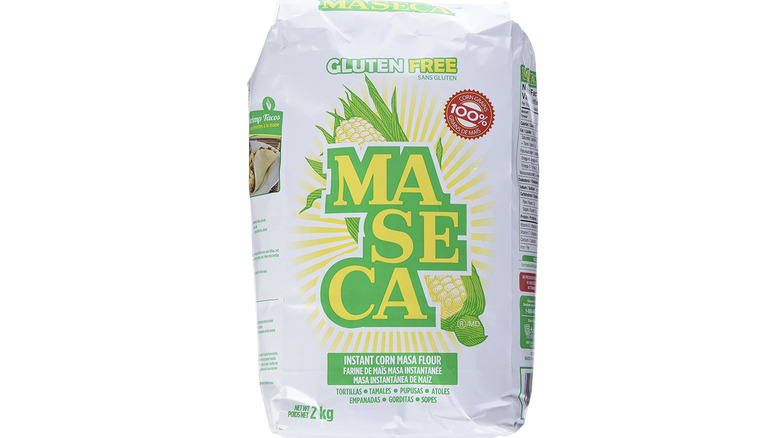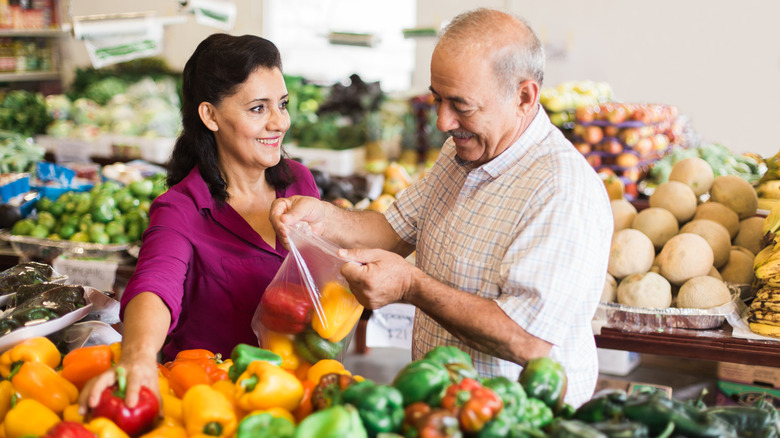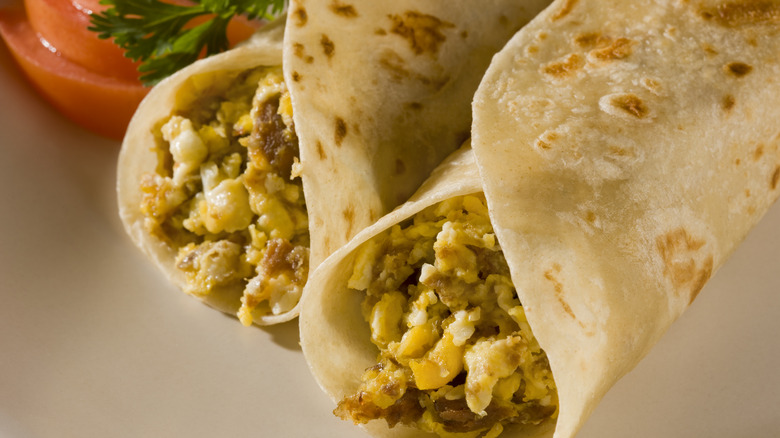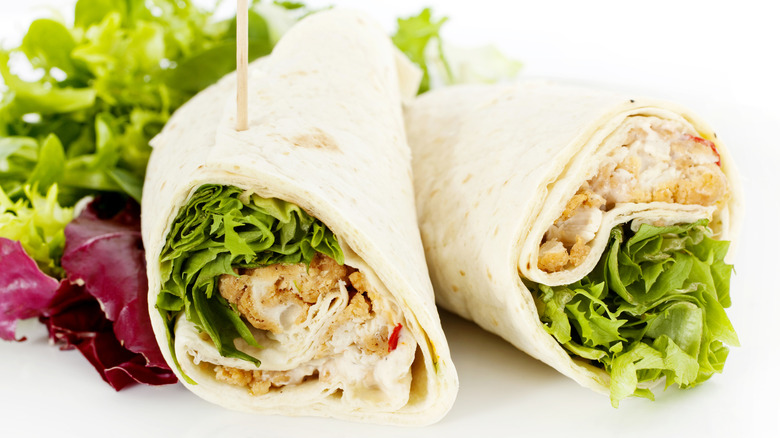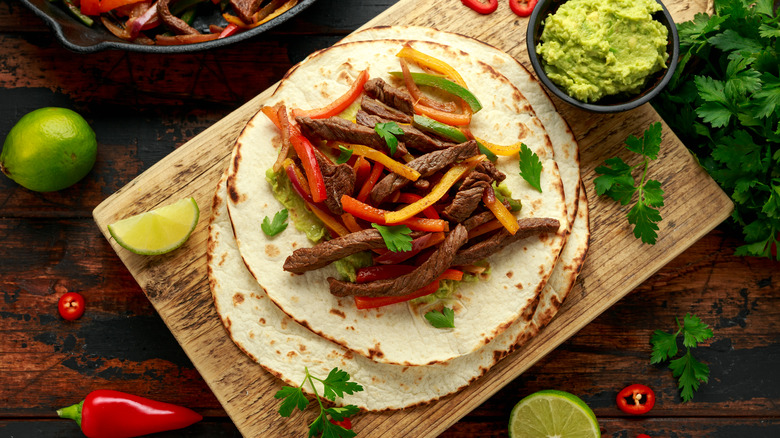16 Mistakes To Avoid When Making Tacos, According To James Beard Award Winner Rick Martinez
We can't imagine a better person to talk to about tacos than Rick Martinez. The former Bon Appétit senior food editor now hosts several YouTube shows about Mexican cuisine, traveling the country to discover new recipes and teaching viewers how to make them. His cookbook, "Mi Cocina," won the 2023 James Beard Award for best international cookbook.
We were able to chat with the Austin, Texas native and current Mazatlán, Mexico resident about common mistakes people make when preparing tacos at home. Although he stressed throughout our exclusive interview that tacos are fun and that the "correct way" to make a taco is very much up to personal taste, the conversation still revealed plenty of ways that home cooks can screw up their tacos. If you're looking to take your Mexican food game to the next level and start making taqueria-quality dishes at home, you'll want to read all of Martinez's helpful tips. Once you stop making rookie mistakes, you'll become a real taquero in no time.
1. Overcomplicating your taco fillings
As Martinez sees it, one of the main things people in the United States get wrong about tacos is that they try to put every component of the dish into the taco filling itself. "In the United States, the filling is given so much attention, and everything else is secondary." He even says he did this himself when we worked at Bon Appétit, trying to create taco fillings with enough texture, sweetness, acidity, and heat to stand on their own without condiments.
Recipes that are built this way aren't necessarily bad; however, this is not how most cooks in Mexico approach tacos. Instead, the taco filling is viewed as just one component of a dish that you build to your taste with toppings and condiments at the table. Trying to cram every flavor you want into the filling itself can lead to needlessly overcomplicated tacos. These days, Martinez prefers simpler recipes. "Simple doesn't mean less delicious. I made a barbacoa recently that blew my mind ... it was simple in terms of ingredients and preparation, but it had so much flavor."
2. Forgetting to set the table with toppings
If you do choose a simpler route with your filling, then having a generous spread of different toppings becomes even more important. You're not maximizing the deliciousness of the tacos unless you serve them with the proper accompaniments. Tacos are a customizable food, and it's fun for everyone to top their tacos with the ingredients they love. "When you serve tacos, there's always going to be condiments on the table ... raw chopped onions, cilantro, lime wedges, multiple salsas," Martinez says. "There are probably going to be dried herbs, maybe dried chiles or fried chiles."
In addition to providing a flavor boost, the toppings are also important for texture. Many taco fillings are soft and need something crunchy to provide contrast. Onions and radishes can do this, but you can get even more creative. "Sometimes when I'm making carnitas, I like to have a little bowl of chicharrones on the table, and you can crumble that on top for some extra crunch."
3. Not tailoring your salsa to the taco filling
In the U.S., it's easy to take a one-size-fits-all approach to salsa. You buy a jar at the grocery store and use it for taco night. But Martinez likes to make his own salsas and pair them with the flavors of the fillings he's preparing.
"It really just depends on what meat I'm serving," Martinez explains. "If I know I'm going to have something that's a little more complex in flavor like a birria or barbacoa, I need to make the salsas maybe a little less flamboyant." Conversely, if the meat or other filling has very simple flavors, he'll choose to create a more intense, complex salsa.
Martinez isn't content to make just one salsa if he's having people over for tacos, either. He likes to have options so people can mix and match as they please. "I'm probably going to make three different salsas." His go-tos are a simple salsa verde that's great with flavorful fillings, a more complex roasted tomato salsa tatemada, and another wild card, often something a little sweet.
4. Ignoring the importance of sweetness
Speaking of sweetness, it's a flavor that's often overlooked in Americanized Mexican food, but Martinez enjoys incorporating it into his taco spreads. One of his new favorites to make, inspired by a friend of his who owns a taqueria in Mexico City, is a caramelized onion and serrano salsa that brings a ton of sweetness and heat. "Imagine a French onion soup flavor, but really spicy from all the caramelized serranos," Martinez says. "It's almost like a jam."
If he's not making the serrano-onion salsa, he frequently turns to something that's even spicier and sweeter. "I've also done habañero jam ... that actually had piloncillo or Mexican brown sugar, onions, garlic, and apple cider vinegar." He uses that sparingly because it's so spicy from the habañeros, but he loves that it gives a little pop of sweetness and heat in each bite. Martinez pointed out to us that sweet chile condiments are a longstanding tradition in Mexican cuisine. "In the central part of the country, there are a lot of people who make pepper jams, primarily with dried chiles."
5. Using yellow onions
Spanish or yellow onions are the most popular type of onion in American and European cooking. They're the default choice because they're super flavorful — they have a ton of sugar and they contain a large amount of sulfur compounds. This means they pack a punch at both ends of the onion flavor spectrum: they're both sweet and sharp. However, the very properties that make yellow onions so great for many global cuisines make them unsuitable for Mexican food. "A lot of Americans use yellow onions in cooking, which tend to be sweeter when cooked and more complex when raw," Martinez says. "White onions have a cleaner, simpler flavor, and I just think they're better on tacos."
And this isn't just Martinez's personal opinion: "Chopped white onion is what is almost universally used in Mexico." If you want your tacos to taste more true to what you'd find in Mexico, always serve them with chopped white (not yellow) onions.
6. Treating the guac as only an appetizer
Chopped avocados or guacamole are another part of the toppings buffet that Martinez sets out with his tacos, but he's noticed a difference between how Americans and Mexicans treat this condiment. "I love a guacamole, but when I make it in the U.S., people always think of guacamole as a chip and dip situation. People eat the guacamole as an appetizer."
While Martinez loves eating guac this way himself, he also notes that guacamole can be so much more than just a dip and advocates for using it as a taco topping. Furthermore, he told us that guacamole isn't just one thing: "In Mexico, guacamole is a category of salsas that all use avocado as their base ... It can be creamy, it can be smooth, it can be liquidy, it can be chunky. There are hundreds, if not thousands, of different varieties of guacamoles." The next time you make tacos, try experimenting with your guac; maybe make a thin, spicy avocado salsa that you can drizzle on top of your tacos instead of scooping up with chips.
7. Serving tacos without lime
There are few mistakes you can make with Mexican food as egregious as forgetting to serve it with lime. As Martinez told us, it's assumed that pretty much any dish in Mexico will be finished with a squeeze of this tart fruit. "You don't taste the food and then add lime, you just squeeze the lime, no matter what it is. It's just a part of the culture here."
Rather than the salsa or the taco filling itself, the lime is what brings acidity to a traditional taco experience. But the limes aren't just adding sourness, either. "When you squeeze the lime, you're also releasing the essential oils, so you're getting a hit of that really beautiful tropical lime flavor."
If you'd like to go above and beyond in recreating Mexican taco flavors, try to find key limes, which are more popular in Mexico and have a different flavor. "They tend to be a little bit sharper and more floral."
8. Adding lime to salsa
Since the lime wedge is adding plenty of acidity to your tacos, you don't need to make your salsas sour with lime juice or vinegar. This is a common practice recommended by American food media (even in some of Martinez's old recipes), but if you're working with the right ingredients, it's unnecessary. "In Mexico, pretty much nobody puts lime juice in their salsas because the tomatoes are good year-round and because you're going to squeeze lime at the end."
For people who are used to acidic salsa, this will require some adjustment. "You just have to retrain yourself on what salsa's supposed to taste like. When you don't put in lime juice, the salsa will be less acidic and sweeter."
Martinez did tell us that he has resorted to lime juice in order to liven up salsas made with bland, out-of-season tomatoes in the U.S. "If you try to make a tomato salsa in January or February, it's going to be gross, and the only way to compensate for that is you either have to cook it or add lime juice at the end to give you some kind of flavor." However, if you're starting with good tomatoes (Martinez recommends using grape or cherry tomatoes if it's not currently tomato season), skip adding lime.
9. Buying stale tortillas
One sad reality of making tacos in the U.S. is that the tortillas available to us in stores — particularly the soft corn tortillas that are used in most traditional Mexican tacos — tend to be poor quality. Martinez put it bluntly: "Store-bought American tortillas are horrible." One problem with buying corn tortillas from a grocery store is that the masa used to make them is naturally quite perishable. In order to make tortillas shelf-stable, they have to be filled with preservatives.
Although you're never going to buy a great corn tortilla in an American grocery store, you can at least make sure you buy fresh ones. "If you look at the package and they're dry or crumbly or they're all stuck together or the edges are frayed or jagged, that means they're super old and I just wouldn't buy them." Martinez said that in this case, it's preferable to turn your fillings and toppings into nachos rather than choking down old, stale corn tortillas. You can also look for little droplets of condensation inside the plastic bag, which means that the tortillas were packaged somewhat recently. The bend test is another good indicator of freshness; simply pick up the bag and bend the tortillas. If they're not soft and pliable, stay away.
10. Not cooking your tortillas
One byproduct of the preservatives in store-bought corn tortillas is an off-taste that's not present in homemade ones. "The preservatives add a slight sourness. If you open a package of corn tortillas at the grocery store, they have this weird sour note to them like somebody put a spritz of vinegar in the bag."
For this reason, you should never use store-bought corn tortillas straight out of the package. Instead, try to mitigate the sourness of the preservatives by cooking the tortillas. Martinez likes to use a grill, griddle, or dry skillet to char store-bought tortillas. "The char marks will add a little bit of bitterness, which will counteract the sour flavor." It doesn't eliminate the sourness, but it does balance it out, making the tortillas more palatable.
If you're not wedded to making soft tacos, turning your tortillas into tostadas is another good option that Martinez suggested. "If you shallow-fry them in oil or put them in a 350-degree Fahrenheit oven for 15 or 20 minutes, they'll taste like toasted corn without any of the off-flavor."
11. Using the wrong masa
Another way to avoid the questionable taste of American corn tortillas is to just make your own at home. Making corn tortillas at home is a bit of a project, but you'll be rewarded with something that tastes much better than anything you can find in a grocery store.
All corn tortillas are made with masa (ground corn), and you have several masa options to choose from. You can use masa harina as we do in our recipe. This is an instant corn flour product that just needs to be mixed with water. If you have access to a Mexican market or live in an area with a high Mexican population, you may also be able to find fresh masa dough at the store.
Martinez endorses both fresh masa and masa harina, but he emphasizes that some types of masa taste better than others. He specifically recommends avoiding the white masa harina from large manufacturers, as it's not very flavorful. However, he likes the yellow and blue versions. "If you can find the blue, those tortillas will be super-flavorful."
12. Shopping at stores that don't specialize in Mexican food
Not everyone lives in an area with a Mexican grocery store nearby, but if you do, Martinez strongly encourages you to shop for your taco ingredients there. That's because the Mexican products at stores that don't cater to Mexican people may not be as fresh or as high-quality. "If you go to a store in a predominantly white neighborhood, those products may never get used except for Cinco de Mayo. They're just going to sit on the shelf forever and be really old and flavorless."
Conversely, Mexican markets (and even standard grocery stores in neighborhoods where many Latinx people live) will be going through a high volume of Mexican foods, meaning that nothing will be gathering dust on a shelf for too long. Although it might seem like a pain to add another store to your usual shopping routine, especially if you're making Mexican food regularly, it's worth it to seek out the best ingredients. Mexican markets will also sell foods that you just flat-out can't get in a standard American supermarket.
13. Dismissing flour tortillas and crispy tacos
Although most of our interview with Martinez focused on soft tacos on corn tortillas — the type of taco you'll most commonly find in Mexico — that doesn't mean he thinks other types of tacos are unworthy of celebration. Avoiding flour tortillas or crispy tacos because you perceive them as less "authentic" is a big mistake.
As a child of Austin, Texas, Martinez is a big fan of breakfast tacos, and he said "To me, breakfast tacos are always flour." He has cherished childhood memories of his mom making chorizo and bean breakfast tacos on homemade flour tortillas. He also has plenty of love for crispy tacos filled with ground beef, particularly puffy tacos from San Antonio.
For Martinez, the Mexican-American food in Texas, New Mexico, Arizona, and California is just much a legitimate tradition as the food in Mexico. "All those states were a part of Mexico at one time. It's like any other state in Mexico, they each have their own distinct cuisines based on the culture, the climate, and the geography."
14. Putting anything in a tortilla and calling it a taco
In the last few years, fusion foods shaped like classic Mexican dishes but made with ingredients from other cultures have really taken off. Sushi burritos replace tortillas with nori. Taco Bell's waffle taco infamously used a folded waffle as its shell. Biryani burritos stuff tortillas with an Indian rice dish. While Martinez is supportive of getting creative with Mexican recipes, he does think it can be taken too far. "Using a tortilla to wrap a Caesar salad and calling it a wrap is fine. Calling it a burrito would be weird, and it doesn't respect the cuisine or the country of origin."
That said, he sees a lot of potential in the blending of flavors and ideas from multiple cultures, like Korean tacos filled with bulgogi. "I think if you're going to call something a taco," Martinez says. "It's even cooler if you blend some Mexican spices and seasonings with your bulgogi. I think that's more interesting, frankly."
15. Tilting your tacos
Throughout our interview, Martinez stressed over and over that there are basically no hard rules when it comes to making tacos. Although he has best practices he likes to follow, he doesn't necessarily think other ways of making tacos are wrong (despite our framing of the interview as a list of taco mistakes). He has just one rule for eating tacos that he considers to be absolutely mandatory: tilt your head, not the taco.
Most of us have probably had all the toppings spill out of a taco while it was on its way to our mouth. It's annoying, but until now, we always chalked this issue up to the intrinsic nature of tacos — sometimes they're just going to fall apart. Martinez informed us that the problem was actually our technique. "When you bite a taco, you always keep the taco completely straight and tilt your head. If you tilt the taco, all the filling and salsas will fall out. If you tilt your head, everything will stay in the taco. You can always tell who is taco-savvy and who isn't by the head tilt." We'll never eat tacos the same way again.
16. Not paying attention to taco construction
Beyond the taco head-tilt, another way to ensure a seamless eating experience is to build your tacos carefully. Different types of fillings require different construction techniques. For crumbly fillings like chorizo or ground beef, you need something wet or pasty to hold the filling inside the tortilla. "If I make a chorizo taco, I'm probably either going to bind the chorizo in scrambled eggs or use a schmear of refried beans. You could even use melted cheese."
Taco fillings cut into too-large pieces can also be a problem. They aren't as likely to fall out as crumbly ones, but they have a tendency to be hard to bite into cleanly. This is especially true for slightly chewy meats like steak. "One thing that I don't like is when things aren't chopped enough. Here, in Mexico, when they make a carne asada taco, it'll be chopped really fine," Martinez explains. "In the U.S., if you order fajitas, they always come in strips, and it's like pulling a rubber band with your teeth."
